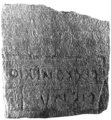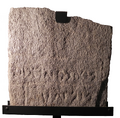VB·22: Difference between revisions
No edit summary |
No edit summary |
||
| Line 1: | Line 1: | ||
{{inscription | {{inscription | ||
|reading=aśkonetio / pianu | |reading=aśkonetio / pianu | ||
|reading_lepontic={{c|O| | |reading_lepontic={{c|O|O2}}{{c|I}}{{c|T}}{{c|E}}{{c|N|N4|d}}{{c|O|O2}}{{c|K}}{{c|Ś}}{{c|A}}<br />{{c|U}}{{c|N|N4|d}}{{c|A|A2}}{{c|I}}{{c|P}} | ||
|direction=sinistroverse | |direction=sinistroverse | ||
|letter_height_min=5 cm | |letter_height_min=3.5 cm | ||
|letter_height_max=6 cm | |||
|letter_number_min=14 | |letter_number_min=14 | ||
|word_number=2 | |word_number=2 | ||
| Line 17: | Line 18: | ||
|frame_right=straight | |frame_right=straight | ||
|workmanship=carved | |workmanship=carved | ||
|condition=complete | |condition=complete, damaged | ||
|type_inscription=funerary | |type_inscription=funerary | ||
|language=Celtic | |language=Celtic | ||
|meaning= 'Pianu the Adgonnetian' or 'Adgonnetio the Pianan' | |meaning='Pianu the Adgonnetian' or 'Adgonnetio the Pianan' | ||
|tibiletti_bruno=14 | |tibiletti_bruno=14 | ||
|solinas=120 | |solinas=120 | ||
|morandi=65 | |morandi=65 | ||
|source_detail=Morandi 2004: 563 f. no. 65 | |source_detail=Morandi 2004: 563 f. no. 65 | ||
|checklevel= | |checklevel=2 | ||
|problem= | |problem=position, David interpretation | ||
}} | }} | ||
== Commentary == | == Commentary == | ||
First published in {{bib|De Giuli 1979}}: 246. | First published in {{bib|De Giuli 1979}}: 246. Autopsied for LexLep on 20<sup>th</sup> April 2024. | ||
Images in {{bib|De Giuli 1979}}: 246 (photo fig. 1 and drawing), {{bib|Tibiletti Bruno 1979}}: 255, fig. 1 (drawing). | Images in {{bib|De Giuli 1979}}: 246 (photo fig. 1 and drawing), {{bib|Tibiletti Bruno 1979}}: 255, fig. 1 (drawing). | ||
{{bib|Tibiletti Bruno 1979}}: 253–257 (254 f.) considers the name formula inverted, with the individual name {{w||pianu}} in line 2, the patronym in {{m||-(i)i̯-}} {{w||aśkonetio}} in line 1 (comparing [[VB·28]] {{w||namu}} {{w||esopnio}} from nearby [[Levo]]; thus also {{bib|Tibiletti Bruno 1981}}: 166 f., no. 14, {{bib|Markey & Mees 2003}}: 139, {{bib|Morandi 2004}}: 564). Alternatively, {{w||pianu}} can be interpreted as a patronym in -''ū'', as per {{bib|De Hoz 1990}}: 323 f. and {{bib|Lejeune 1971}}: 53 (see [[The Cisalpine Celtic Languages]]); thus {{bib|Solinas 1995}}: 372, no. 120, critical {{bib|Eska 1995}}: 43 β. | Inscribed on what is today the lower area of the slab, at 25 cm distance from the top edge; the stone's original shape being unknown, it is not clear how the inscription was situated originally. It is written sinistroverse in two right-aligned lines (length line 1 45 cm, line 2 27.5 cm). Both lines are inscribed in rectangular frames, sharing the line in between them; the frame of line 2 (length 40 cm, height 13.5–17 cm) is shorter than that of line 1 (length 50.5 cm, height 13 cm), which covers the entire breadth of the stone, though longer than necessary for the short sequence {{w||pianu}}. The inscription is heavily abraded, but the letters are unambiguously legible. The alphabet is the Lepontic one; the only irregular letter shape is that of nu in both lines, which looks like inverted Lepontic nu but with hasta and angle of the same height – the letter seems to be a compromise between Lepontic and Latin nu, and also appears in [[VB·27]]; cf. also [[VB·26]] for inverted Lepontic nu. | ||
{{bib|Tibiletti Bruno 1979}}: 253–257 (254 f.) considers the name formula inverted, with the individual name {{w||pianu}} in line 2, the patronym in {{m||-(i)i̯-}} {{w||aśkonetio}} in line 1 (comparing [[VB·28]] {{w||namu}} {{w||esopnio}} from nearby [[Levo]]; thus also {{bib|Tibiletti Bruno 1981}}: 166 f., no. 14, {{bib|Markey & Mees 2003}}: 139, {{bib|Morandi 2004}}: 564). Alternatively, {{w||pianu}} can be interpreted as a patronym in -''ū'', as per {{bib|De Hoz 1990}}: 323 f. and/or {{bib|Lejeune 1971}}: 53 (see [[The Cisalpine Celtic Languages]]); thus {{bib|Solinas 1995}}: 372, no. 120, critical {{bib|Eska 1995}}: 43 β. | |||
See also {{bib|Tibiletti Bruno 1978c}}: 24 f. | See also {{bib|Tibiletti Bruno 1978c}}: 24 f. | ||
{{bibliography}} | {{bibliography}} | ||
Revision as of 18:46, 9 May 2024
| Inscription | |
|---|---|
| Reading in transliteration: | aśkonetio / pianu |
| Reading in original script: | |
|
| |
| Object: | VB·22 Stresa (stela) |
| Position: | front |
| Orientation: | 0° |
| Frame: | |
| Direction of writing: | sinistroverse |
| Script: | North Italic script (Lepontic alphabet) |
| Letter height: | 3.5–6 cm1.378 in <br />2.362 in <br /> |
| Number of letters: | 14 |
| Number of words: | 2 |
| Number of lines: | 2 |
| Workmanship: | carved |
| Condition: | complete, damaged |
|
| |
| Archaeological culture: | La Tène D 2 [from object] |
| Date of inscription: | 1st c. BC [from object] |
|
| |
| Type: | funerary |
| Language: | Celtic |
| Meaning: | 'Pianu the Adgonnetian' or 'Adgonnetio the Pianan' |
|
| |
| Alternative sigla: | Tibiletti Bruno 1981: 14 Solinas 1995: 120 Morandi 2004: 65 |
|
| |
| Sources: | Morandi 2004: 563 f. no. 65 |
Images
Commentary
First published in De Giuli 1979: 246. Autopsied for LexLep on 20th April 2024.
Images in De Giuli 1979: 246 (photo fig. 1 and drawing), Tibiletti Bruno 1979: 255, fig. 1 (drawing).
Inscribed on what is today the lower area of the slab, at 25 cm distance from the top edge; the stone's original shape being unknown, it is not clear how the inscription was situated originally. It is written sinistroverse in two right-aligned lines (length line 1 45 cm, line 2 27.5 cm). Both lines are inscribed in rectangular frames, sharing the line in between them; the frame of line 2 (length 40 cm, height 13.5–17 cm) is shorter than that of line 1 (length 50.5 cm, height 13 cm), which covers the entire breadth of the stone, though longer than necessary for the short sequence pianu. The inscription is heavily abraded, but the letters are unambiguously legible. The alphabet is the Lepontic one; the only irregular letter shape is that of nu in both lines, which looks like inverted Lepontic nu but with hasta and angle of the same height – the letter seems to be a compromise between Lepontic and Latin nu, and also appears in VB·27; cf. also VB·26 for inverted Lepontic nu.
Tibiletti Bruno 1979: 253–257 (254 f.) considers the name formula inverted, with the individual name pianu in line 2, the patronym in -(i)i̯- aśkonetio in line 1 (comparing VB·28 namu esopnio from nearby Levo; thus also Tibiletti Bruno 1981: 166 f., no. 14, Markey & Mees 2003: 139, Morandi 2004: 564). Alternatively, pianu can be interpreted as a patronym in -ū, as per De Hoz 1990: 323 f. and/or Lejeune 1971: 53 (see The Cisalpine Celtic Languages); thus Solinas 1995: 372, no. 120, critical Eska 1995: 43 β.
See also Tibiletti Bruno 1978c: 24 f.
Bibliography
| Caramella & De Giuli 1993 | Pierangelo Caramella, Alberto De Giuli, Archeologia dell'Alto Novarese, Mergozzo: Antiquarium Mergozzo 1993. |
|---|---|
| De Giuli 1978 | Alberto De Giuli, "Le stele funerarie di Brisino", Bollettino Storico per la Provincia di Novara 69/1 (1978), 13–20. |
| De Giuli 1979 | Alberto De Giuli, "Le stele funerarie di Brisino", Sibrium 14 (1978–1979), 245–252. |
| De Hoz 1990 | Javier de Hoz, "El genitivo celtico de los temas en -o-", in: Francisco Villar (ed.), Studia indogermanica et palaeohispanica in honorem Antonio Tovar et Luis Michelena, Salamanca: Ediciones Universidad de Salamanca 1990, 315–329. |
| Eska 1995 | Joseph F. Eska, "Observations on the thematic genitive singular in Lepontic and Hispano-Celtic", in: Joseph F. Eska, R. Geraint Gruffydd, Nicolas Jacobs (eds), Hispano-Gallo-Brittonica. Essays in honour of Professor D. Ellis Evans on the occasion of his sixty-fifth birthday, Cardiff: University of Wales Press 1995, 33–46. |



